Inversion table exercises and workouts have grown in popularity in recent years as a means of reducing back discomfort, enhancing posture, and flexibility, gain height.
Inversion table therapy has several advantages, whether you’re an athlete wanting to improve your performance or someone who spends a lot of time sitting in an office chair, or want to get relief from back pain, increase height, gain flexibility and stretchability whatever…
This is considered one of the effective approaches. And with no doubt, you’ve made a good decision. You’ll surely see good results and differences.
So, with that said, in this comprehensive guide, I’ll walk you through everything you need to know about cutting-edge inversion table exercise and workout, routine, do’s and don’ts, etc..
Key Benefits of Inversion Table Exercise & Workout Therapy
Hanging upside down or at an angle that simulates hanging upside down in order to utilize gravity as a means of relieving pressure on the spine and other regions of the body is the practice of inversion therapy.
There are numerous advantages associated with inversion therapy, some of them are as follows:
People who suffer from a wide variety of illnesses, such as herniated discs, sciatica, spinal stenosis, and many more can benefit from inversion therapy, which is another sort of physical therapy that is very helpful.
It helps to alleviate pain and promote recovery in these patients.
Fitness With Inversion Table
![Inversion Table Exercise & Workout Therapy Instruction [ Must-Read Guide ] inversiontablehub.com](https://inversiontablehub.com/wp-content/uploads/2023/02/Red-and-Black-Dark-Gamer-Sports-YouTube-Outro-18-1024x576.webp)
Using an inversion table for exercise can provide your body with a multitude of benefits, including enhanced circulation, increased flexibility, and strengthened muscles.
Inversion therapy consists of hanging upside down or at an angle to relieve pressure on the spine and lessen compression, which can improve posture and relieve back pain.
Furthermore, hanging upside down helps improve blood flow to the head and upper body, reducing weariness and increasing energy levels.
Stretching and strength training exercise can also be done on inversion tables.
Stretching upside down can help loosen stiff muscles in the back, neck, and legs, increasing overall flexibility.
Inverted leg raises, crunches, and twists can also aid in developing the muscles of the core, back, and legs.
To avoid harm, start carefully and listen feel the the pressure on your body, and take things lightly. As you go by and get comfortable then you can exert pressure.
Additionally, for best results, inversion tables should be utilized in conjunction with a well-rounded fitness plan that includes cardiovascular exercise and strength training.
Finally, including an inversion table in your training regimen can bring a range of benefits for your body while also helping to improve overall health and well-being.
Because the inverted posture has several health advantages for the body, inversion tables can be used for fitness objectives.
The advantages include:
Improved Circulation: Increasing blood flow to the head and upper body while hanging upside down can aid with energy levels and fatigue reduction.
Stretching: Stretching and loosening stiff muscles in the back, neck, and legs with back exercises will increase flexibility overall.
Strength Training: The muscles in the core, back, and legs can be strengthened by performing inverted leg lifts, crunches, and twists.
Reduced Stress: By enhancing general posture and lowering the chance of injury, inversion treatment can help reduce stress and tension in the back and neck.
To prevent harm, it’s crucial to start off gently and pay attention to your body.
You should also speak to a doctor before using an inversion table, especially if you have any health issues or questions.
For best results, inversion tables should be utilized along with a well-rounded fitness program that incorporates both strength training and cardiovascular exercise.
Inversion Table Workout Routine
When using an inversion table for exercise, it’s important to stick to a routine. This helps make sure that the equipment is being used in a safe and effective way.
A routine gives your inversion therapy structure and consistency.
It also lets you gradually increase the amount of time you spend upside down and the intensity of your exercises. This can help you get the results you want and reduce the chance of getting hurt.
A basic inversion table workout entails hanging upside down or at an angle to stretch the muscles in your back, neck, and legs as well as release pressure on the spine.
Here Is a Sample Inversion Table Exercise Workout Routine:
| Exercise | Time (in minutes) | Sets | Repetitions |
|---|---|---|---|
| Inverted hang | 1-2 | 2-3 | Hold for 30 seconds |
| Inverted crunches | 1-2 | 2-3 | 8-12 |
| Inverted twists | 1-2 | 2-3 | 8-12 |
| Inverted leg raises | 1-2 | 2-3 | 8-12 |
| Inverted back stretch | 1-2 | 2-3 | Hold for 30 seconds |
In brief, you can perform the following Inversion table exercises
Warm-Up
Spend 5-10 minutes warming up by doing some light cardio exercise, such as jumping jacks or walking on a treadmill.
Inverted Hang
Simply hang upside down with your hands free and your back relaxed. Start with 30 seconds and increase to two to three minutes.
Inverted Crunches
Perform a regular crunch while hanging upside down by bringing your knees to your chest. 8 to 12 times total.
Inverted Twists
Bring one knee up to your chest while hanging upside down, then turn your torso to touch the knee to the opposite elbow.
Repeat on each side 8–12 times.
Inverted Leg Raises
Raise your legs to a 90-degree angle while hanging upside down, hold for a second, and then lower. 8 to 12 times total.
Inverted Back Stretch
Turn yourself upside down and slowly extend your back. Keep your body in this position for 30 to 60 seconds.
To prevent damage, it’s crucial to start out cautiously and pay attention to your body. If you have any medical ailments or worries, talk to your doctor before utilising an inversion table.
Cool-Down
Spend 5-10 minutes stretching and doing light cardio exercises to cool down and bring your heart rate back to normal.
Note: To prevent damage, it’s crucial to start out cautiously and pay attention to your body.
Depending on each person’s fitness level and goals, the duration, number of sets, and repetitions may change.
Starting with a lower period and fewer repetitions is advised, and then progressively increasing over time. Before beginning any new workout program, seek medical advice.
>>> Beginner’s Guide To Inversion Table <<<
Inversion Table Exercise To Get Relief From Back Pain
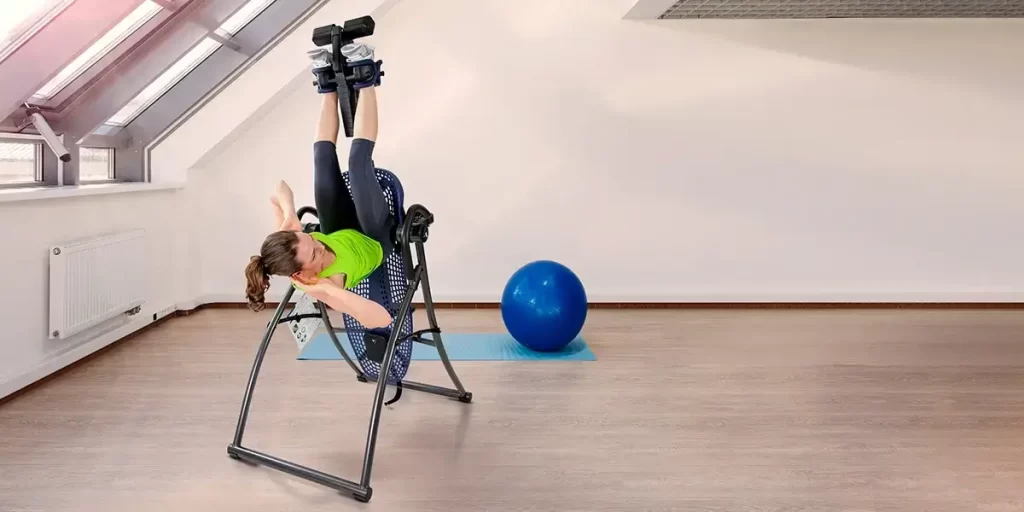
No doubt, that inversion workout therapy is very effective in getting relief from back pain.
The theory behind inversion therapy is that by hanging upside down or at an angle, you can take pressure off of your spine and reduce compression, which can help relieve pain and improve posture.
The primary function of the vast majority of inversion tables is to merely facilitate back stretching.
The user has the ability to select whether they wish to be partially inverted or entirely upside down, and once inverted, they can opt to stay that way for brief intervals of time or remain that way for longer sessions.
Here are the benefits you can observe–
Reduced Amount of Pain
Patients who suffered from chronic low back pain were included in a study conducted by Healthline, that investigated how inversion traction affected their levels of discomfort, flexibility in the low back, and muscle strength.
Improved Flexibility
It is essential to have a flexible spine in order to allow joints to move through their full range of motion, which is also necessary for proper posture, maintaining balance, and avoiding accidents.
Upside Down Back Stretch Is Effective To Get Back Pain Relief
People who are experiencing back pain or stress, as well as people who are wanting to improve their posture, are often the ones who benefit most from performing the Upside Down Back Stretch with the inversion table.
It is particularly good for people who spend extended periods of time sitting or standing in the same posture, as it helps to stretch and relax muscles that have been tight from staying in one position for so long.
The following are the stages involved in carrying out this exercise:
>>> Are Inversion Tables Good For You ? 🤸🏼 <<<
How To Use Inversion Tables For Lower Back Pain?
Here is an overview of how to use an inversion table for lower back pain relief:
Adjust The Inversion Table: Make sure the inversion table is properly adjusted to your height and weight, and that the safety straps are securely fastened.
Start Slowly: Begin by hanging upside down or at a slight angle for just a few seconds, and gradually increase the time as you get used to the inversion table.
Focus On Relaxation: While hanging, focus on relaxing your back, neck, and muscles. Breathe deeply and try to release any tension in your body.
Hold The Position: Hold the inverted position for 30 seconds to 1 minute, and then slowly return to an upright position. Repeat the exercise several times, gradually increasing the length of time you spend inverted.
Stretching: While hanging upside down, you can also perform gentle stretches to help loosen tight muscles in your back, neck, and legs.
Cool-Down: After using the inversion table, spend a few minutes stretching and doing light exercises to help cool down and bring your heart rate back to normal.
Note: In case, if you have serious issues with your back pain or have any medical condition, then I suggest consulting your doctor and discussing your condition using an inversion table.
The above-discussed steps are for those for casual use. So, just mind that.
>>> Who Should Not Use An Inversion Table 🤸 <<<
Inversion Table Therapy Exercise & Workout To Fix Spinal Stenosis
Spinal stenosis occurs when the spinal canal narrows, compressing the spinal cord or nerve roots. Inversion table therapy can be a beneficial exercise and workout for people who have spinal stenosis.
The steps for performing an inversion table therapy exercise for spinal stenosis are as follows:
Before beginning any inversion table therapy exercises, contact with a doctor or chiropractor, especially if you have spinal stenosis.
They can advise you on the best course of action to take in order to manage your disease and reduce your symptoms.
For the best success in reducing back pain and increasing spinal health, inversion table therapy should be done in conjunction with other forms of exercise and physical therapy.
>>> Inversion Table Negative Side Effects & Risk <<<
Inversion Table Therapy Exercise To Fix Sciatica
Inversion table therapy is a type of exercise that can help alleviate sciatica by using an inversion table to gently invert the body and reduce pressure on the spine.
This type of therapy can help improve circulation and reduce inflammation, promoting faster healing. It is important to start slowly and gradually increase the angle of an inversion over time.
Before starting, it is recommended to consult a doctor or chiropractor for advice.
Inversion table therapy can be an effective way to manage sciatica symptoms and improve overall spinal health when used in conjunction with other forms of exercise and physical therapy.
Start slowly: Start with an angle of inversion that is low, such as 15-30 degrees, and gradually increase it throughout the course of the exercise.
Secure your feet: Be sure your feet are properly fastened in the ankle clamps before commencing the inversion. Before beginning the inversion, make sure your feet are securely fastened in the ankle clamps.
Increase angle gradually: Gradually raise the angle of inversion until you feel a small stretch in your back while avoiding discomfort. Gradually increase the angle of inversion until you feel a mild stretch in your back.
Focus on breathing and relaxation: Concentrate on taking deep breaths and relaxing your muscles while you are upside down. While you are in this position, focus on taking long, slow breaths and relaxing your back muscles.
Repeat and increase duration: Repeat the exercise while progressively increasing the duration of the inversion each time, while simultaneously decreasing the angle at which you are inverted and increasing the total time spent in the inverted position.
Use in conjunction with other therapy: Utilization in conjunction with other forms of treatment For the best possible outcomes, inversion table therapy should be utilized in conjunction with many other forms of exercise and physical therapy.
If you follow these instructions, you should be able to benefit from inversion table therapy, including a reduction in sciatica pain as well as an improvement in the health of your spine.
>>> Sciatica Inversion Table <<<
Inversion Table Exercise To Gain Extra Height
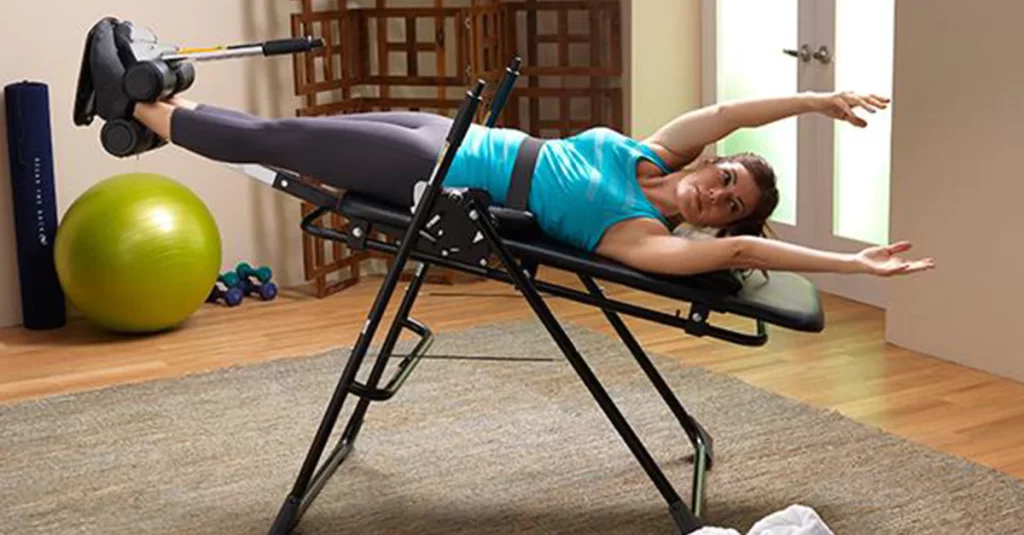
Inversion table therapy has recently gained popularity as a method of height growth. A slight gain in height may result from the spinal stretching that it causes.
Inversion table therapy can be a useful tool for improving posture and spinal health, even if it does not result in a noticeable rise in height.
Starting slowly and progressively increasing the angle of an inversion over time is crucial when utilizing an inversion table to gain height.
Start at a small angle (around 15-30 degrees) and increase it slowly until you feel a gentle stretch in your back. As you hang upside-down, take some deep breaths and unwind your back muscles.
In order to promote flexibility and improve posture, inversion table therapy should be combined with other types of exercise, such as yoga and stretching.
Keeping to healthy food and way of life is also essential, as it has positive effects on your body as a whole and may even cause you to gain height.
If you seriously want to height increase your height and you’re ready to do so anything for that then in my opinion, having an inversion table should be a top priority.
Apart from that, do everything that is needed, like a proper healthy diet from a dietician, but you can always watch and listen to experts on YouTube platforms, consulting doctors is a good idea, maintaining a healthy lifestyle, etc.
Inversion table therapy is not a foolproof procedure for gaining height, therefore results may vary.
The right thing to say is that the result is uncertain. And in my opinion, an inversion table therapy workout works.
Before beginning a new Inversion table exercise and workout regimen, it is recommended that you seek a medical professional, such as a chiropractor, to get the best observable result in height increment.
But if you want it to be casual, then it’s still good.
All you need is the best inversion table and a proper therapy exercise to learn about. And then you can begin.
>>> Who Should Not Use An Inversion Table 🤸 <<<
Here is the brief instruction to consider if you want to use an inversion table for the exercise:
Inverted Hang:
Inverted Twist:
Inverted Back Stretch:
You can help improve spinal alignment and gain more height over time by including these exercises in your inversion table program.
Keep in mind to pay attention to your body, and as you start to feel more comfortable, gradually raise the inversion angle.
Consult a doctor or chiropractor: It’s crucial to seek the advice of a medical professional before beginning any new exercise program to verify that it is secure and suitable for your particular requirements.
Start Off Slowly
Start with a low angle of inversion—say, 15 to 30 degrees—and raise it gradually as you get more comfortable and your body adjusts.
Focus On Deep Breathing
Focus on deep breathing: Invert yourself and concentrate on deep breathing while relaxing your back muscles. As a result, circulation will increase and stress will be reduced.
Use In Conjunction With Other Forms of Exercise
When used in conjunction with other forms of exercise, such as yoga and stretching, inversion table therapy can assist to improve posture and increase flexibility.
Maintain a Healthy Lifestyle
Maintaining a good food and lifestyle, in addition to regular exercise, will assist improve general health and possibly enhance height.
Increase The Angle of Inversion Gradually
As your body adjusts over time, you can progressively raise the angle of inversion to get a deeper stretch. Don’t overdo it in the start.
>>> Amazing Benefits Of Inversion Tables <<<
Take Notice of Your Body
Pay attention to the warnings your body sends you, and stop if you feel any pain or discomfort. There should never be any discomfort during inversion table therapy.
Inversion table therapy can be used as a component of a thorough exercise program to help you raise height, relieve back discomfort, or enhance spinal health by following these steps.
Final Thought
To sum up, inversion table therapy can be a beneficial form of exercise for people who want to gain height, stretchability, and flexibility, and get relief from back pain, stenosis, Sciatica, etc.
If you consider Inversion table therapy exercise and workout on casual basis, daily routine exercise, getting some relief from general back pain, or body flexibility…then, in that case, you won’t require to consult a doctor. You can get basic knowledge regarding how to do an inversion table exercise.
On the other hand, if you’re going through any condition, then make sure you consult your doctor regarding the use of an inversion table for exercise and workout therapy.
That’s it.
There are still many topics needed to discuss like the best Inversion table to use for a specific purpose, but that is enough for now.
I’d like to recommend you read my article, where I have discussed everything about Inversion Table. Make sure to take look around.
>>> An Ultimate Guide To Inversion Table <<<
FAQs
Who Should Not Use An Inversion Table ?
Inversion table therapy is not recommended for patients who suffer from hypertension, circulation abnormalities, glaucoma, or retinal detachments. When hanging upside down, either partially or totally, the head and eyes experience an increase in both pressure and blood flow.
How Does An Inversion Table Work For Exercise?
To decompress the spine and relieve pressure on the back and joints, an inversion table works by inverting the user’s body against the force of gravity. It is possible to improve circulation, alleviate back discomfort, and develop flexibility by turning the body upside down.
What Are The Benefits Of Using An Inversion Table For Exercise?
When used for fitness, an inversion table offers a number of benefits, including enhanced circulation, decreased levels of back discomfort, enhanced levels of flexibility, enhanced levels of posture, decreased levels of joint tension, and improved levels of mental clarity.
Is It Safe To Use An Inversion Table For Exercise?
If you stick to the instructions and recommendations provided by the inversion table’s manufacturer, then using one for exercise should not pose any significant health risks.
If, on the other hand, you have any pre-existing medical disorders, such as high blood pressure, glaucoma, or cardiac difficulties, you should talk to a physician before utilizing an inversion table. This is because it is suggested that you do so.
Can An Inversion Table Help With Back Pain?
There is some evidence that using an inversion table can alleviate back pain by relieving pressure on the spine and enhancing blood circulation. However, before utilizing an inversion table for back discomfort, it is strongly advised that a consultation with a medical professional take place.
Are There Any Precautions I Should Take Before Using An Inversion Table For Exercise?
It is crucial to warm up and stretch before using an inversion table for exercise since this will help prevent injury. In addition, check that the inversion table is correctly adjusted and fastened, and make sure to adhere to all of the safety precautions and instructions provided by the manufacturer.
Can I Lose Weight By Using An Inversion Table For Exercise?
When incorporated into a comprehensive fitness plan that also involves changes to one’s diet and various other forms of physical activity, using an inversion table as part of one’s workout routine can be beneficial for weight loss.
However, it is not a foolproof way for shedding extra pounds and should not be relied on as the one and only strategy for accomplishing one’s weight loss objectives.
How Do I Adjust The Angle Of An Inversion Table For Different Exercises?
Adjusting the inversion table’s angle to meet the requirements of the user as well as the specific workout being carried out is possible with these devices. The handbook that is provided with the inversion table ought to have instructions on how to alter the angle at which the table is positioned.
>>> Inversion Table Exercise & Workout Therapy <<<
![Inversion Table Exercise & Workout Therapy Instruction [ Must-Read Guide ] inversiontablehub.com](https://inversiontablehub.com/wp-content/uploads/2023/02/Red-and-Black-Dark-Gamer-Sports-YouTube-Outro-18.webp)
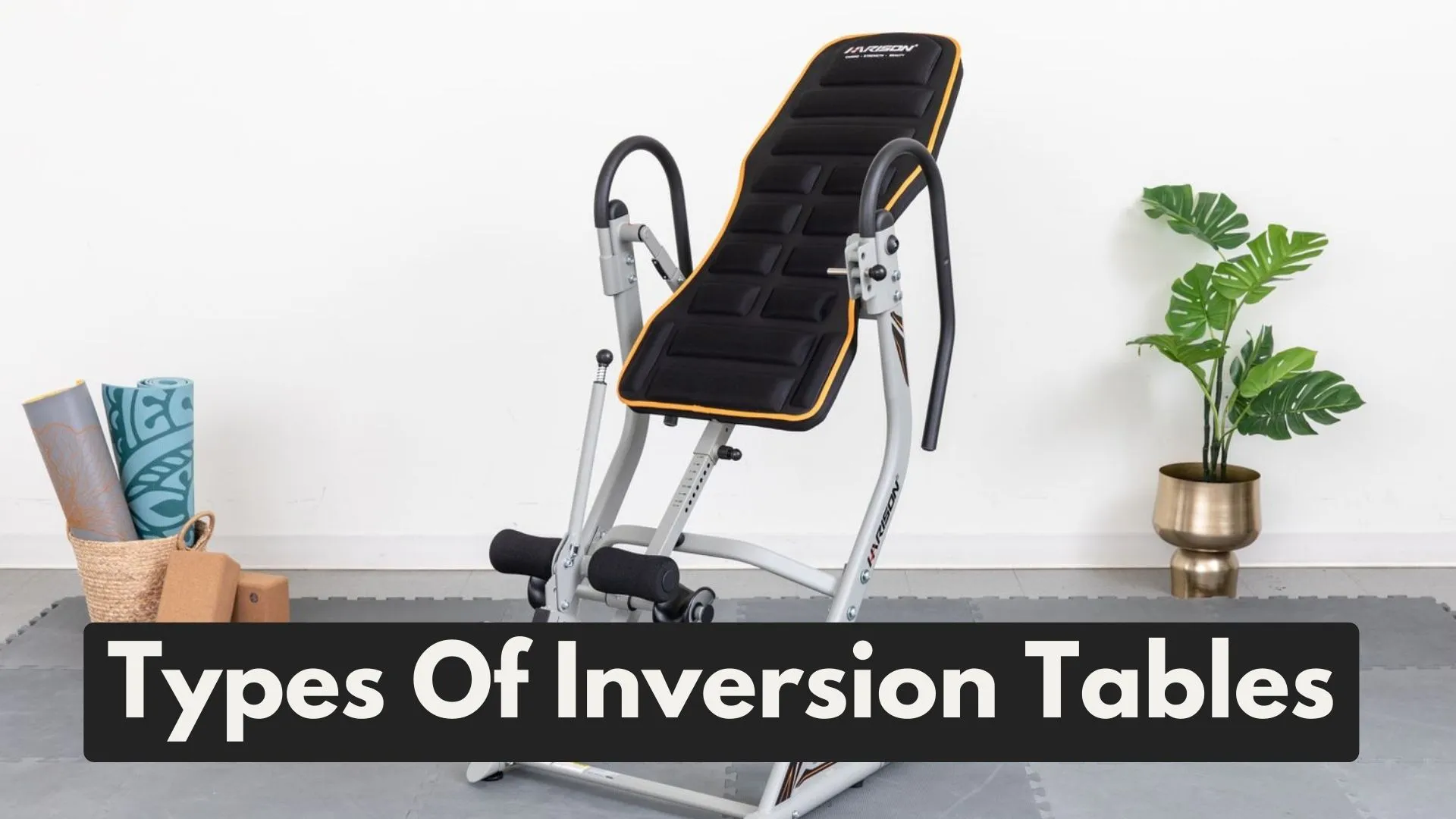
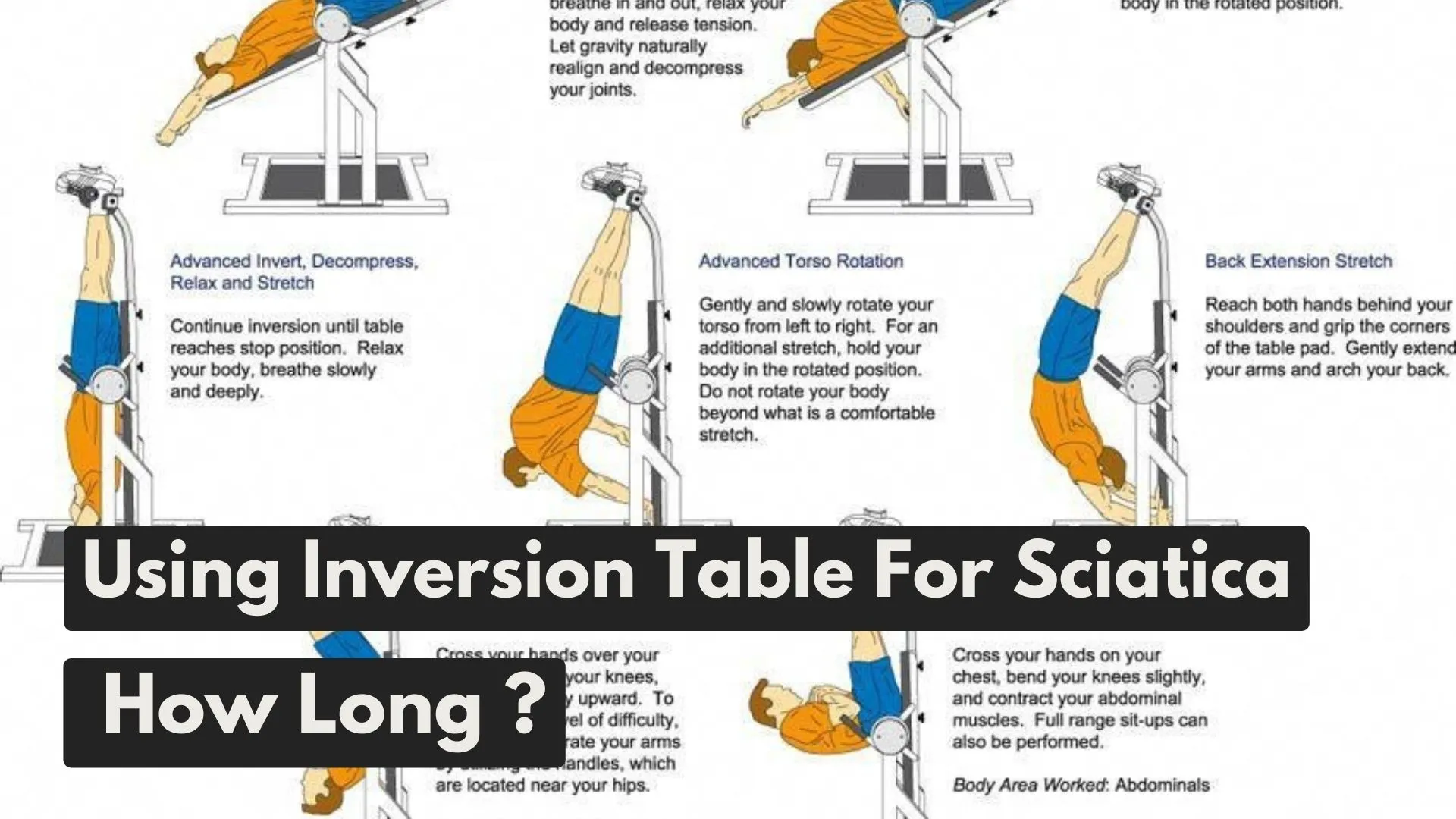

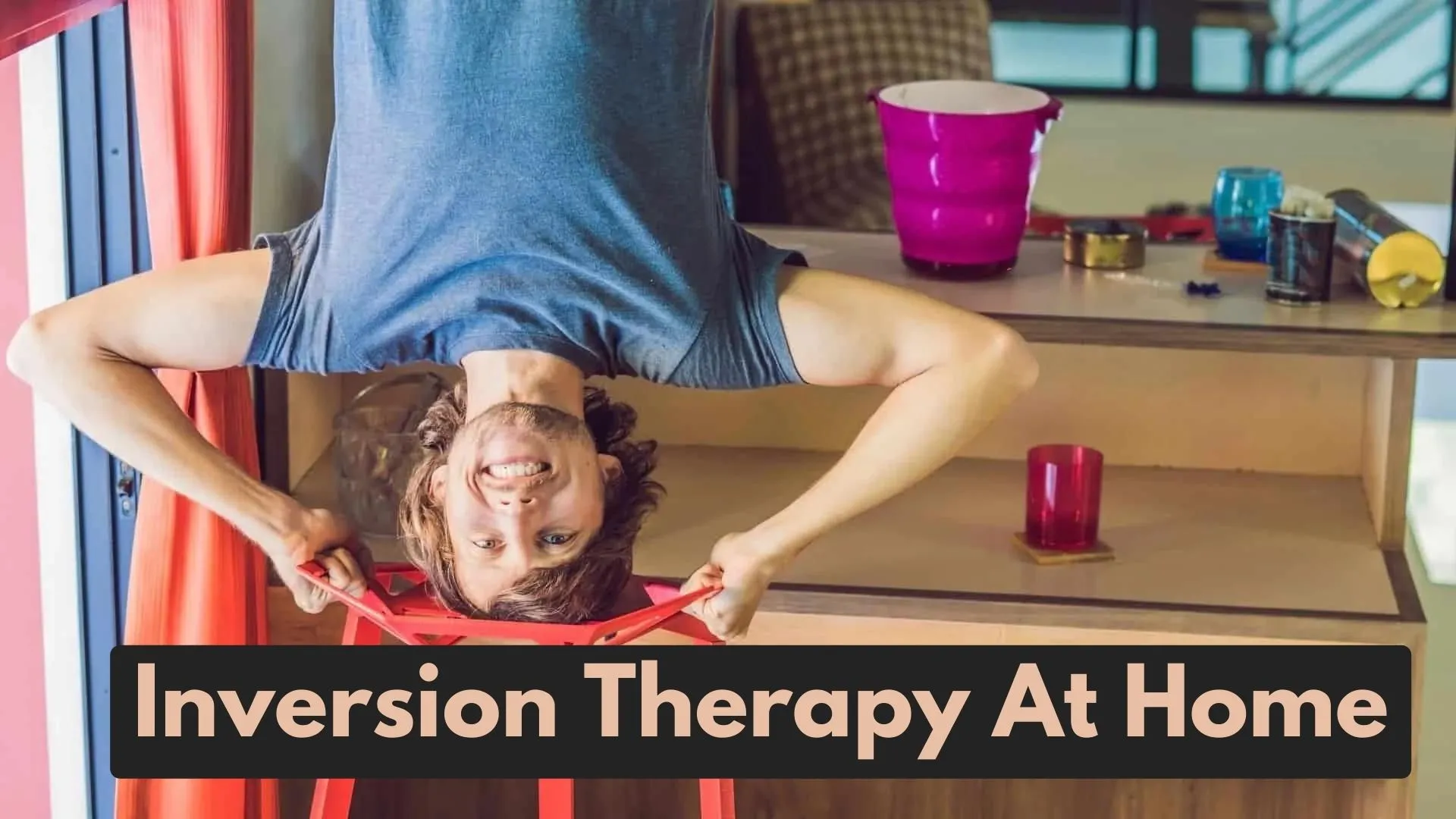
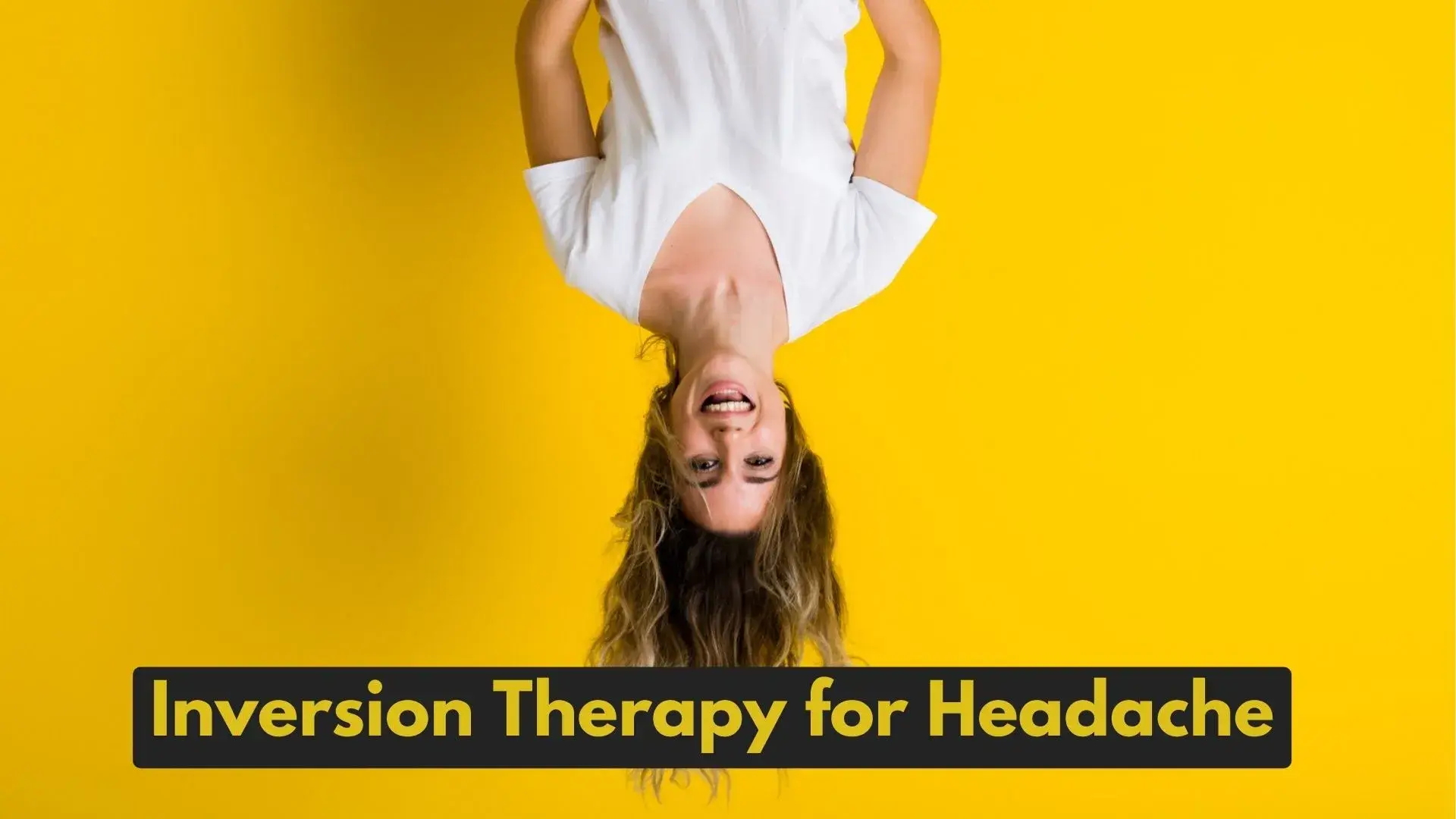




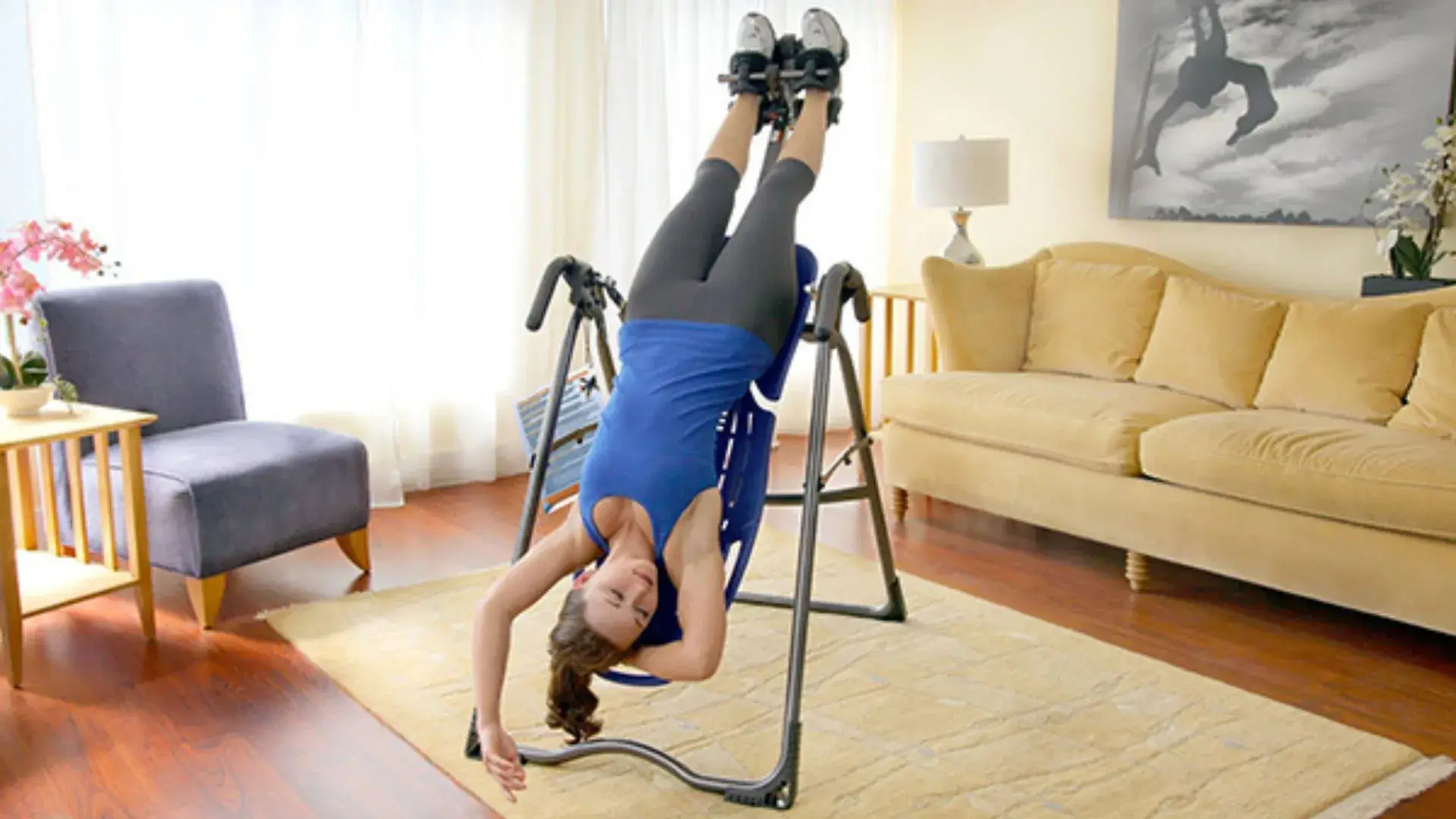





Leave a Reply